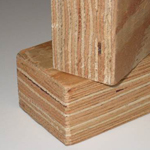
Engineered Wood Products
Wood is a natural, biological material; wood products made from solid pieces of the same species have inherent property differences that can be problematic. Engineered composite wood products are manufactured so as to attempt to reduce this variability.
Learning Objectives
After viewing this presentation and relevant support material, users should be able to:
- Explain the impact of variability of wood products on the calculation of allowable design stresses of those wood products.
- Describe the composition of examples of engineered lumber composites compared to solid wood alternatives.
- Explain, using named examples, how the composition of engineered lumber composites reduce their
variability and can therefore result in higher allowable design stresses compared to solid wood alternatives.
Presenter
Listen to Dr. Simon Ellis respond to the question: How did I get interested in this area of study? by clicking on his photo.
For information about Dr. Ellis, please check UBC, Faculty of Forestry
Module Resources
Presentation
![]() Forestry – Engineered Wood Products
Forestry – Engineered Wood Products
Dr. Simon Ellis begins by discussing the properties of wood and giving a few examples of solid wood products. Then he focuses on explaining the benefits of engineered wood products and describing five products in detail: laminated veneer lumber (LVL), glue laminated timber (Glulam), Parallam®, TimberStrandTM, and I-beams.
Other Resources
General
- Naturally:Wood – videos on use of various engineered products.
- Forest Products Association of Canada
- Forest Products Society – organizations relating to wood products under “Links and resources” tab.
- A Revised Taxonomy of Wood Products – from UBC Faculty of Forestry and the Canadian Forest Service.
Glossary of wood product terms
Diagrams and Media
- How lumber is sawn.
- Veneer cuts
- Plywood core types
- Southern Pine Association (USA) – videos and images under “Media” tab.
Potential Questions for use by Instructors
Since wood is a natural, biological material there will always be inherent property differences between individual solid pieces of the same wood species. Engineered lumber composites are manufactured so as to attempt to reduce this variability.
- Please explain what advantages there are to reducing the level of variation between pieces of the same structural product. Use appropriate diagrams or figures to help illustrate your answer in some detail.
- For one named engineered lumber composite product, please describe its composition and explain how its composition helps to reduce its variability. Describe any additional benefits that the product’s composition provides.

